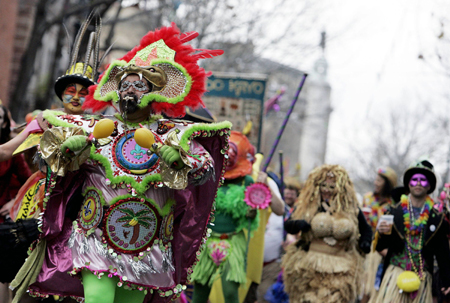"Mardi Gras" is French for “Fat Tuesday”. It is the name of a celebration that takes place on the day before Ash Wednesday, which marks the beginning of the 40-day period of Lent. Mardi Gras is the final day ofa three-day period, which starts on the Sunday before Ash Wednesday. In Catholic countries, people fast during lent. People eat well the day before Ash Wednesday and hold celebrations. These can be wonderful, colourful carnivals all over the world. The most famous are those in Rio de Janeiro, New Orleans and Venice. The tradition of Mardis Gras goes back hundreds of years in Catholic Europe. Explorers, settlers and missionaries exported the tradition worldwide.
"Mardi Gras"的法語意思為“油膩的星期二”。這一天是圣灰星期三之前的一項慶祝節(jié)日,也預示著40天大齋活動的開始。Mardi Gras也是三天的最后一天,此項節(jié)日開始于圣灰星期三之前的周日。在信奉天主教的國家里,人們要在大齋期間絕食。人們會在圣灰星期三之前吃得飽飽的,并舉辦慶祝活動。全球都會舉辦熱鬧非凡,五彩紛呈的嘉年華活動。其中最著名的要數(shù)在里約熱內(nèi)盧、新奧爾良以及威尼斯所舉辦的活動。在信奉天主教的歐洲,Mardis Gras有著上百年的歷史。探險者、移民者以及傳教士讓這一傳統(tǒng)傳遍了大江南北。

Today, Mardi Gras is a riot of colour, street carnivals, marching bands, dancing and all-night partying inthe streets. Many people dress up in spectacular costumes and wear beautiful masks. The biggest Mardis Gras carnivals are in Rio de Janeiro, Brazil, and New Orleans, Louisiana. Thousands of people from all over the world visit these cities to join in the fun. Venice is home to one of the oldest carnivals in the world,called Carnevale di Venezia. This dates back to 1268. Thousands of mask-wearing revelers fill the Venetian streets and attend special masked balls. In Sydney, Australia, Mardis Gras is celebrated by the city’s gay and lesbian community with street parades and costumes.
如今,Mardis Gras節(jié)當天會舉辦嘉年華、行進軍樂隊演奏、舞蹈以及大街上通宵的派對活動。許多人穿著奇裝異服,戴著華麗的面具。舉辦規(guī)模最大的嘉年華要數(shù)巴西的里約熱內(nèi)盧、美國的新奧爾良以及路易斯安那。來自全球的上千名民眾都前往這些城市來參加狂歡。威尼斯曾經(jīng)舉辦過全世界最古老的嘉年華,叫作威尼斯狂歡節(jié)。歷史能夠追溯到1268年。上千名戴著面具的狂歡者涌進了威尼斯大街,參加特殊的假面舞會。在澳大利亞的悉尼,同性戀和女同社區(qū)組織將會在大街上穿著奇裝異服進行游行,從而來慶祝此項節(jié)日。
譯文屬可可英語原創(chuàng),未經(jīng)允許,不得轉(zhuǎn)載。











